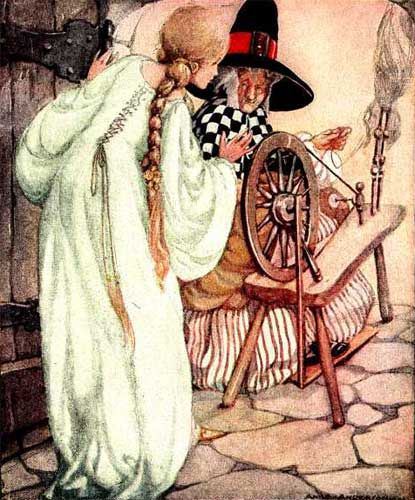Heroine’s Journey: Learning to Work
You may remember that a while ago, I wrote a series of posts about the Fairy Tale Heroine’s Journey. I was teaching a class on fairy tales (I just finished teaching that class last month), and I realized that there was an underlying pattern to many of the fairy tales I was teaching. I called it The Fairy Tale Heroine’s Journey, and in a series of blog posts I starting trying to define it. Based on those posts, I was asked to write about it for Faerie Magazine, and an article of mine called “Into the Dark Forest: The Fairy Tale Heroine’s Journey,” was published in the Spring 2015 issue.
Here are the steps in the Fairy Tale Heroine’s Journey, as I defined them:
1. The heroine receives gifts.
2. The heroine leaves or loses her home.
3. The heroine enters the dark forest.
4. The heroine finds a temporary home.
5. The heroine finds friends and helpers.
6. The heroine learns to work.
7. The heroine endures temptations and trials.
8. The heroine dies or is in disguise.
9. The heroine is revived or recognized.
10. The heroine finds her true partner.
11. The heroine enters her permanent home.
12. The heroine’s tormentors are punished.
Now that classes are over and I have an entire summer to . . . well, catch up on my other work, I thought I would return to defining the Fairy Tale Heroine’s Journey. I want to map out the entire journey and relate it to a set of fairy tales, probably about twelve total. So this will take a while. Today, while it’s on my mind, I want to write about work.
Learning to work is a central part of many fairy tales that share this pattern. Of course we have the “Cinderella”-type tales, in which Cinderella has to cook and clean. She essentially becomes the housekeeper for her stepmother and stepsisters. In the Grimm version “Aschenputtel,” her stepmother specifically asks her to sort bowls of lentils out of the ashes before she can go to the ball. She is helped by the birds that represent her mother’s spirit, so there is an aspect of work that is passed on from mother to daughter: the mother helps the daughter out. The same thing happens in “Vasilisa the Beautiful,” where Vasilisa is helped by the doll her mother gave her. But in that story, too, Vasilisa must do housework for Baba Yaga as well as for her stepmother and stepsisters. Snow White keeps house for the dwarves. Donkeyskin works as the lowest maidservant in a kitchen. Even Beauty, who does not need to work in the Beast’s castle, works as a servant — this time voluntarily — in her own home after her father loses his fortune, rising at four in the morning to do her chores. (Madame de Beaumont had a pretty strict idea of virtue!) In “Six Swans,” the heroine needs to sew the shirts that will save her brothers and return them to their human forms.
There are some important exceptions: in “Sleeping Beauty,” work actually kills the princess, or at least puts her to sleep for a hundred years. As soon as she touches the spindle, she falls asleep. Work happens off-screen in”Rapunzel.” We are told that Rapunzel lives alone for several years with her children, which means she must be supporting them somehow, but we are not told how. Notice, however, that in the Disney version of “Sleeping Beauty,” Princess Aurora must live in a cottage in the forest with the three fairies, where she does housework. The Disney versions tend to standardize fairy tales, using parts of one to fill in narrative gaps in another. Aurora in the fairies’ cottage echoes Snow White with the dwarves. Notice also that in The Wizard of Oz, which incorporates so many of the old fairy tale structures, Dorothy must work for the Wicked Witch of the West.
Often, in these fairy tales, it is exactly the heroine’s work that leads to her final reward. Dorothy kills the witch with the water she was using to wash the floor. Donkeyskin drops her ring into the dish she is preparing for the prince, which allows him to identify her. Vasilisa wins the hand of the Tsar because she makes linen shirts so fine that he must see who wove and sewed them, and then falls in love with her beauty. When she is told that she must sew the shirts, she even says, “I knew all the time . . . that I would have to do this work.” Of course the heroine in “Six Swans” saves her brothers and proves her virtue through her sewing. In “East o’ the Sun and West o’ the Moon,” the heroine proves her worth by washing the tallow from her husband’s shirt, winning him back from the trolls.
There’s a reason for this emphasis on work, I think. Most of these fairy tales came out of the folk tradition, and peasant women worked. They were proud of their work, and their work was seen as a mark of their worth. It proved that they were good potential wives and mothers. A good woman was also an industrious spinner and weaver, a good needlewoman. So in fairy tales, even princesses need to learn how to work. Sleeping Beauty may be an exception because she comes to us out of the romance tradition: one of the earliest versions of the story appears in the prose romance Perceforest, composed in France around the 1340s. It is the tale of Troilus and Zellandine, and in it Zellandine wakes up not when her beloved kisses her, but when one of the children she has borne while still asleep sucks a piece of flax out of her finger. Whereas folk tales were the literature of the folk, romances were often associated with the aristocracy. Perceforest is written in six books: the tale of Troilus and Zellandine came from and belonged to those who had books and could read them — those, in other words, who did not have to work. Still, there is something thematically important about the fact that Sleeping Beauty falls into her deathly sleep when she takes up what was considered women’s work — in other words, when she reaches maturity. We are still looking, here, at a woman’s journey toward adulthood and marriage.
I think the emphasis on work is an important part of these tales. Which brings us back to ourselves: our own journeys so often involve learning to work. There’s a sense in which work was written out of women’s stories around the time of the Industrial Revolution. If you look at the novels of Jane Austen, they ask the fundamental question: “Whom shall the heroine marry?” There is no interval of work in the journey from the father’s to the husband’s house. By that time, work was a class issue: working meant losing your status as a lady. Only lower-class women worked, and they were largely not the province of the novel. Jane Eyre is so revolutionary in part because it gives us a woman who learns to work before she finds her proper mate, and because she finds sustenance and self-respect in her work. It is only after going through an interval of serious work as a teacher in a poor village that Jane can come back to Rochester. But then, Jane Eyre has a deep fairy tale structure: it starts as “Cinderella,” goes on to become a “Bluebeard” story, and ends as “Beauty and the Beast.” We do, I think, both find and prove ourselves through work. Work is a fundamental part of fairy tales, as it was a fundamental part of the lives of the people who told them. So once again fairy tales can reveal an important truth:
If you want a happy ending, learn to work.
(The image of Sleeping Beauty at the spinning wheel is by Anne Anderson.)
Previous posts in this series:
The Heroine’s Journey
Heroine’s Journey: Snow White
Heroine’s Journey: Sleeping Beauty
Heroine’s Journey: Receiving Gifts
Heroine’s Journey: The Goose-Girl
The Heroine’s Journey II
Heroine’s Journey: The Dark Forest






